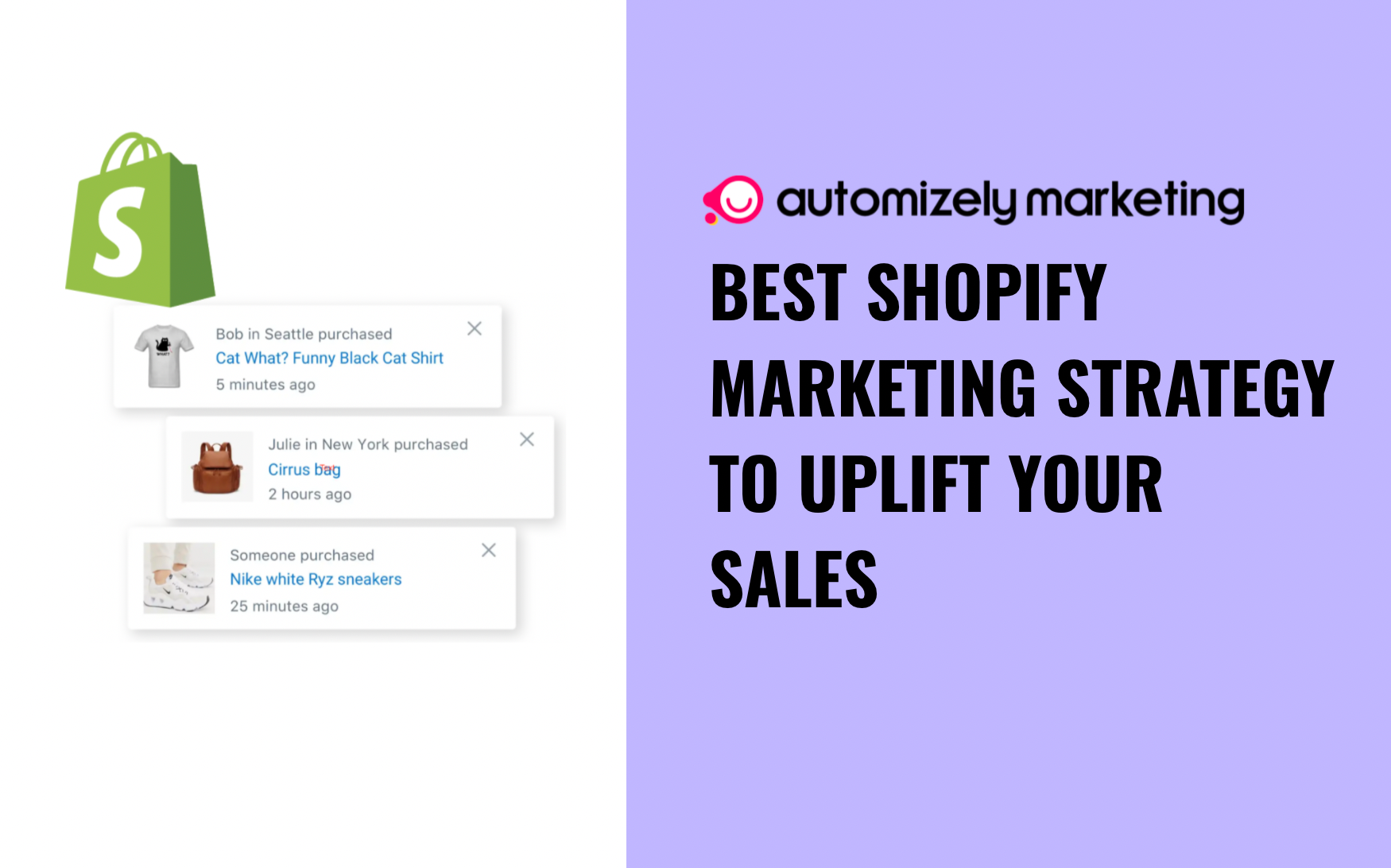Ecommerce is more competitive than ever, so an effective Shopify marketing strategy is essential for success.
But where should you start?
There are countless marketing strategies, tactics, and methods out there — from Facebook ads and referral programs to influencer marketing and push notifications — which ones should you use?
To make things even more complicated, every marketing tactic needs to fit into an overarching Shopify marketing strategy to help you get the most bang for your buck. But how can you create one?
In this article, you'll learn how to market a Shopify store, step-by-step. We'll also explore numerous Shopify marketing methods and how to piece them together into a powerful strategy.
By the end of this article, you'll have the knowledge you need to create a reliable, scalable system that’ll help you turn strangers into customers. Alright, let's dive in.
Understand the Marketing Funnel
First things first: Let's use a popular framework to understand how the marketing funnel works.
In the image below from HubSpot, you can see the 4 stages of the marketing funnel and how they move people from strangers to brand promoters:
Shopify Marketing Strategy Stages
Let's quickly take a look at each stage's key objective:
- Attract: Get the attention of your target market.
- Convert: Capture users' information so you can nurture the relationship.
- Close: Use sales tactics to compel people to make a purchase.
- Delight: Delight your customers to produce brand promoters.
In the rest of this article, we'll explore each of these stages, step-by-step. Plus, we'll highlight some of the key marketing methods and tactics to use in each step.
Step 1. Attraction Methods
Every Shopify marketing plan needs to start with attraction methods. In other words, you need a way to bring in new customers. Here are 4 popular ways to do this:
1. Use Social Media
Social media marketing is perhaps the cheapest organic (i.e., 'free') Shopify marketing method available. So, if you want to keep your Shopify marketing costs low, start here.
Ultimately, the aim is to grow a loyal and engaged following with killer on-brand content and posts. For example, the apparel brand Chubbies regularly shares quippy posts that resonate with their target market:
Chubbies Social Media Marketing Example
Keep in mind that it can take time to build a sizable and engaged following. So, how can you drive sales with social media marketing in the meantime? In short, strike up relationships with individuals.
In the image below, you can see how Bulletproof coffee takes the time to tweet individuals personally:
Bulletproof Coffee Social Media Marketing Example
2. Start Influencer Marketing
You can also tap into other people's social media success by partnering with influencers to promote your offers to their existing audiences.
The jewelry brand Missoma partnered with the YouTube influencer Fashion Mumblr to promote its products to her YouTube subscribers.
Influencer Marketing Example: Fashion Mumblr
3. Advertise
If you want to hit the ground running, probably the fastest way to scale your Shopify marketing efforts is to use an advertising platform like Google Ads or Facebook Ads.
These two platforms alone provide countless advertising options:
- Google Ads allows you to advertise on Search, YouTube, and the Google Display Network.
- Facebook enables you to reach your target market on Facebook, Instagram, and Messenger.
How to Market My Shopify Store: Google Search Shopping Ads
These popular Shopify advertising tools also offer incredible targeting capabilities that allow you to home in on your ideal customers for maximum impact.
How to Market Shopify Store: Instagram Ads
4. Start a Referral Program
If you're looking for another scaleable Shopify marketing tactic, consider starting a referral program.
Here’s an excellent example from the apparel brand Rothy's, which incentivizes customers to refer friends by offering them $20 for every new customer they help to create:
Shopify Business Strategy: Rothy's Referral Program
You can get started with this Shopify marketing tactic by using an app like Referral Candy or Smile.
Step 2. Conversion and Nurture Tactics
After you've captured your target market's attention, what's next?
Well, before you go straight for the sale, you first need to capture people's contact details and then nurture relationships with them.
This is the conversion stage of the Shopify marketing strategy that we talked about at the start of this article — the process of converting a website visitor into a lead.
Let's explore 3 ways to capture website visitor's information.
1. Capture Email Addresses
Email marketing is a simple and effective way to nurture leads — especially as you can automate the process with Shopify email marketing tools like Automizely.
You can capture email addresses on your website in many ways, too.
The food brand Flourist takes the standard Shopify marketing approach and uses a popup to offer website visitors a discount for signing up:
Flourist Email Capture Example
You can install Automizely to capture email addresses with popups in this way.
In another example, the perfume brand Bailly uses a live chat feature to collect email addresses from website visitors.
Bailly Email Capture Example
2. Harness the Power of Push Notifications
Another great way to remarket to website visitors is to request permission to send them push notifications.
In the image below from Death Wish Coffee, you can see a web push notification example welcoming a new subscriber:
Death Wish Coffee Web Push Notification Example
Again, Automizely makes it dead-simple to start remarketing to website visitors with web push notifications.
3. Use Ad Retargeting
Ad retargeting is another highly effective way to nurture leads, although it's arguably more complicated to set up than email marketing and web push notifications.
To get started, you need to install a piece of code on your website called a 'pixel.' This code automatically tags website visitors and allows you to follow them around the internet to serve them ads.
For example, I visited the apparel brand Cuts' website:
Cuts Retargeting Example 1
After, I headed to Facebook and was served this retargeting ad from Cuts:
Cuts Retargeting Example 2
Is this Shopify marketing strategy creepy? Maybe. Is it effective? Definitely!
Step 4. Sales Tactics
After you've converted visitors into leads and nurtured them with emails, push notifications, or ads, it's time to close the sale.
There are numerous Shopify marketing tactics that you can use to compel leads to make a purchase — here are 6 of our favorites:
1. Highlight Benefits
When writing copy for ads, emails, and product pages, keep this essential Shopify marketing tip in mind: always highlight your offer's benefits.
Here's what I mean: Instead of focusing on your offer's features, also emphasize how those features benefit customers.
Take the makeup brand Beauty Bakerie who boldly calls out the benefits of its products in simple terms. For example, "Apply your Lip Whip and leave it at home. Don't worry about reapplying."
Beauty Bakerie Benefits Example
2. Harness the Power of Social Proof
People are heavily influenced by the opinions of others. As a result, another essential Shopify marketing tactic is to use social proof to establish authority and trustworthiness.
Social proof comes in many forms, such as testimonials and impressive affiliations.
For example, BLK and Bold coffee has a section on its homepage dedicated to showcasing notable websites that have featured the company.
BLK and Bold Coffee Social Proof Example 1
The brand also highlights customer reviews and star ratings on products pages:
BLK and Bold Coffee Social Proof Example 2
You can also use Automizely to showcase social proof popups that call out purchases made by other customers:
Best Shopify Marketing App: Automizely Social Proof Popups
3. Craft Compelling Product Pages
No Shopify store marketing strategy is complete without incredible product pages. So, how can you optimize your product pages to generate more sales?
Let's check out an example of a great product page from shoe brand Allbirds:
All Birds Optimized Product Page
To start, notice the many professional product images. Essential information is presented at the top of the page, including the product name, a star rating, and the colors available for purchase.
Next, you'll see the sizes available, along with a link to learn more about sizing. Then, there's a call to action (CTA): "Select a size."
Allbirds also highlights the product's benefits with small images before providing a drop-down menu featuring more comprehensive information.
4. Use Scarcity and Urgency
FOMO — the fear of missing out — can play a subtle role in compelling leads to make a purchase.
To emphasize scarcity, you could use a free Shopify marketing app like Automizely to create a stock countdown bar like the one featured below by Adored Vintage.
Adored Vintage Stock Countdown
You can also use Automizely to create urgency with a timer that counts down until the end of a sale.
Best Shopify Marketing App: Automizely Countdown Timer
5. Cross-Sell and Upsell
Cross-selling and upselling are straightforward yet powerful ways to increase sales. Here's how they work:
- Cross-selling is the act of promoting complementary products.
- Upselling is the process of encouraging buyers to upgrade their purchases in some way.
In the example below featuring a desk chair, Staples uses the checkout process to upsell furniture protection and cross-sell chair mats:
Staples
6. Recover Abandoned Carts
A massive 69.8% of online shopping carts are abandoned, so recovering abandoned carts must be part of your Shopify marketing strategy.
One of the most effective ways to do this is to set up an automated email sequence to follow up with shoppers who abandon their cart. For example, check out the abandoned cart email from the photography retailer Moment below:
Moment: Abandoned Cart Email Example
Step 5. Retention Methods
Once you've made the sale, the next step of your Shopify strategy should be to increase repeat business and turn customers into brand promoters. How? Here are 2 ways:
1. Start a Rewards Program
Offering customers rewards can help keep them engaged and incentivized to make additional purchases.
So, what should your rewards program look like? Take a look at Chubbies' reward program in the image below:
Chubbies Rewards Program
Chubbies uses a points-based system to reward customers for making purchases and following the brand on social media. Customers can then reclaim these points as a discount on future purchases.
You can use apps like Growave and Smile to set up a Shopify marketing rewards program like Chubbies'.
2. Delight Customers With Stellar Service
The best way to win repeat business is to provide an incredible shopping experience, fantastic products, and stellar customer service.
In the example below, Fitbit took the initiative to reach out to a Twitter user to help them fix their watch's screen.
Fitbit Customer Service Example
This customer didn't even ask for help — let alone be put on hold for 45 minutes before speaking to a call center agent reading from a script.
The moral of the story? Find ways to provide exceptional service and turn customers into diehard fans and promoters.
Create a Shopify Marketing Strategy to Turbo-Charge Sales
Whether it's social media marketing, push notifications, or ad retargeting, every Shopify marketing campaign you run should fit into an overarching strategy.
In summary, here's how to create a Shopify marketing plan that will convert strangers into repeat customers:
- Attract: Use Shopify marketing methods to get the attention of your target market, such as social media marketing, influencer marketing, advertising, and referral programs.
- Convert: Secure a way to remarket to website visitors. For example, you could use email marketing, push notifications, or ad retargeting.
- Close: Land sales with Shopify sales tactics like cross-selling, upselling, urgency, and abandoned cart recovery emails.
- Delight: Generate repeat business from customers and turn them into brand promoters with stellar customer service and an attractive rewards program.
Finally, don't forget to take advantage of the best Shopify marketing apps like Automizely, which allows you to set up and manage many of these tactics!


